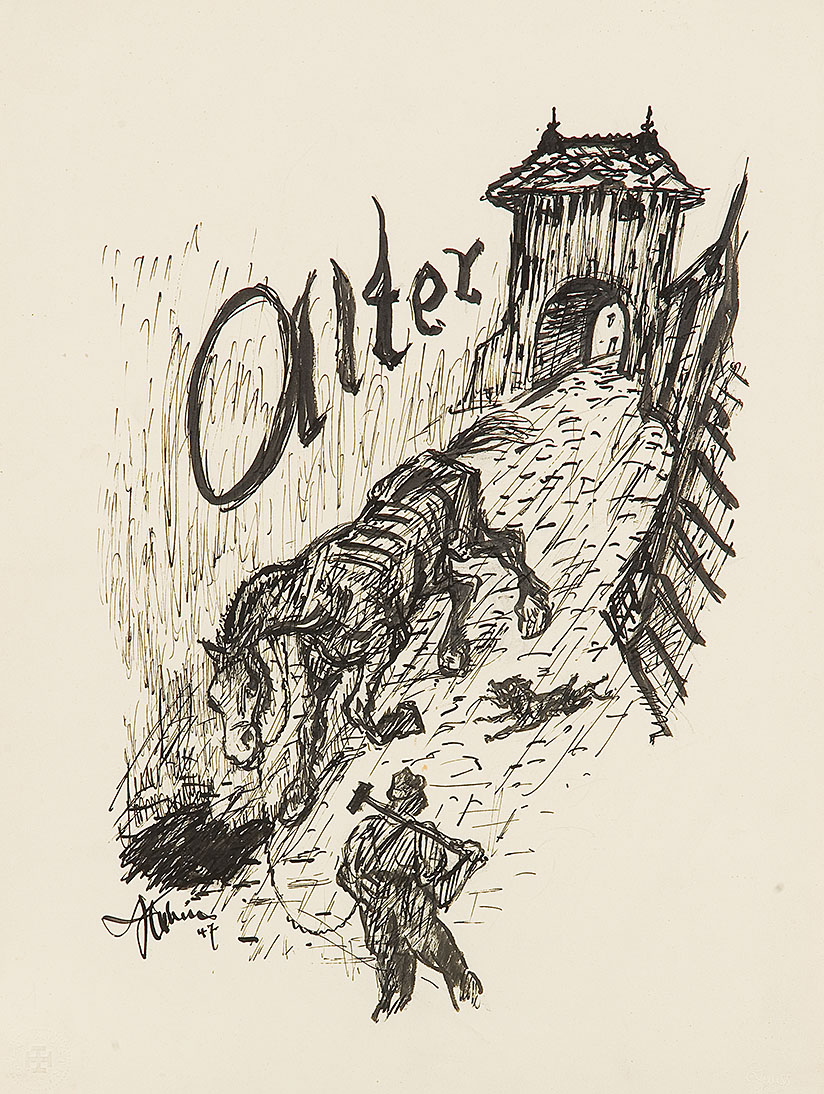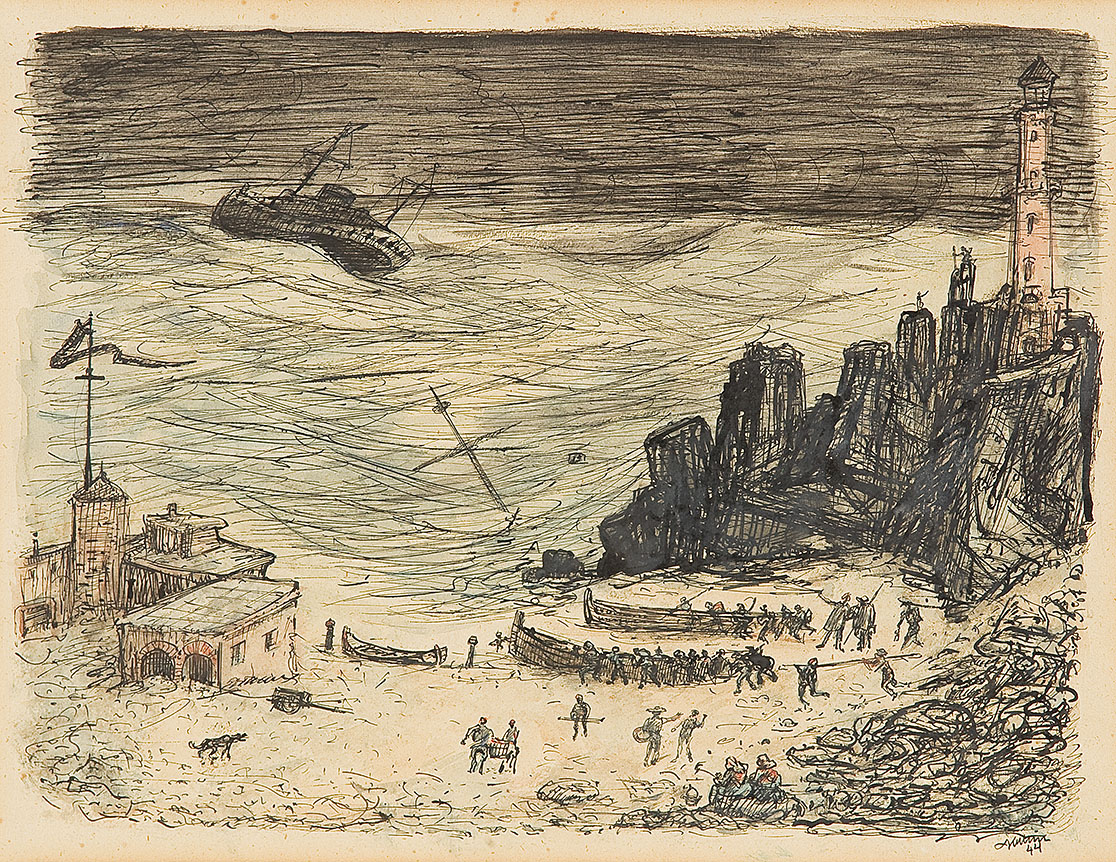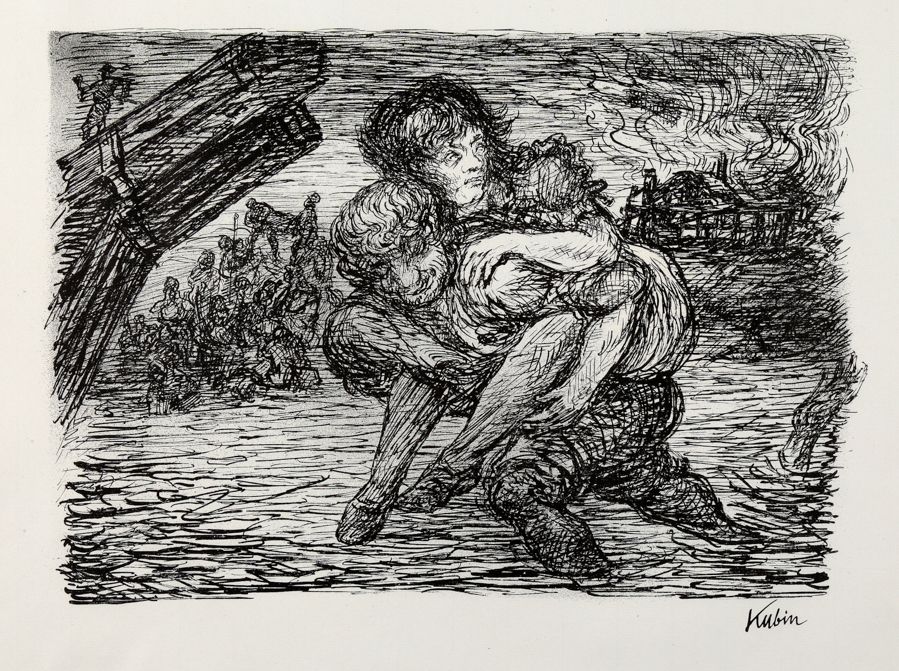ALFRED KUBIN* (Leitmeritz 1877 - 1959 Zwickledt) Robbenjagd, 1949 Tusche/Papier, 23,2 x 18 cm signiert A. Kubin und datiert 49 verso beschriftet Kap York/Grönland Provenienz: Privabesitz Wien SCHÄTZPREIS: € 1.500 - 3.000 Österreichischer Maler, Grafiker und Buchillustrator des 20. Jahrhunderts. Zunächst als Fotograf tätig, ab 1898 in München an der privaten Malschule von Ludwig Schmid-Reutte 1902 erste Ausstellung in Berlin. 1903 Herausgabe der Webermappe, ermöglicht durch die Förderer Max Dauthendey und Hans von Weber. Ab 1906 in Wernstein am Inn auf Schloss Zwickledt ansässig. V.a. als Zeichner tätig, schuf Einzelblätter und Folgen, die als Mappen und Buchillustrationen erschienen. 1912 und 1913 Beteiligungen an Ausstellungen des Blauen Reiters. Lebenslange Freundschaft mit Fritz von Herzmanovsky. Ab 1912 Illustrationen für den Simplicissimus. Werke geprägt von unheimlichen und gespenstischen Elementen, Auseinandersetzung mit Arbeiten von James Ensor Max Klinger Edvard Munch und Odilon Redon Parallelen zu E. T. A. Hoffmanns, F. Dostojewskijs und E. A. Poe V.a. Tuschezeichnungen, oft mit dämonischen, alptraumhaften Szenen und Hang zum Grotesken. Auch Auseinandersetzung mit historischen Themen oder humorvolle Darstellung menschlicher Eigenschaften. Alfred Kubin erlebte eine unruhige Kindheit. Die Mutter starb früh, und die Familie übersiedelte häufig. Unsicher, welcher Berufung er folgen sollte, absolvierte er zunächst eine Fotografenlehre. 1898 ging Kubin nach München, studierte an der Akademie, bildete sich aber bald autodidaktisch weiter. Entscheidend für den jungen Kubin war die Begegnung mit den Werken von Ensor, Klinger, Munch und Redon. Seine erste Ausstellung in Berlin 1902 rief Unverständnis hervor. Mit dem Dichter Max Dauthendey und dem Sammler und Verleger Hans von Weber stellten sich jedoch bedeutende Förderer ein. Die Herausgabe der Weber-Mappe 1903 brachte den Durchbruch. Bereits im Frühjahr darauf war Kubin in der Secession-Ausstellung vertreten. Er lernte Fritz von Herzmanovsky kennen, mit dem ihn eine lebenslange Freundschaft verband, und knüpfte Kontakte zu bedeutenden expressionistischen Künstlern. 1912 begann er für den neu gegründeten „Simplicissimus“ zu arbeiten. Während des Ersten Weltkrieges beschäftigte sich Kubin mit Psychoanalyse und Philosophie. 1921 hatte er seine erste Retrospektive. Er stellte eine große Anzahl Lithografien her und war auch literarisch tätig. Unzählige Arbeiten in Zeitschriften und Illustrationen für Literaten folgten. Kubins Œuvre ist voller überraschender Bildideen aus seiner an Motiven schier unerschöpflichen Lebens- und Traumwelt – voll von Geheimnissen und Abgründen, Skurrilität und Banalitäten, wobei sich viele seiner Zeichnungen jeder herkömmlichen Lesart entziehen. Vielleicht liegt darin auch ein Grund, warum Kubins Bilderkosmos zumeist als Pandämonium kategorisiert wird. Diese allzu einseitige Lesart hat das Heitere, Humorvolle wie auch allzu Menschliche im grafischen Werk Alfred Kubins zu Unrecht in den Schatten gestellt. Dabei ist es gerade seine subtile Karikatur auf das bürgerliche Phäakentum und die allzu demonstrativ zur Schau gestellte Genussfreudigkeit. In der Tuschezeichnung mit der Robbenjagd wird eine kulturelle Praxis gezeigt, die zu Kubins Zeiten nicht so stigmatisiert war wie heute. Während die Robbenjagd zur traditionellen Lebensweise unterschiedlicher indigener Völker wie etwa der Eskimos gehört, ist es vor allem die industriell betriebene Robbenjagd, gegen die Naturschützer spätestens seit den 1970er Jahren mit zunehmendem Erfolg kämpfen. Kleidung und Bewaffnung der beiden Jäger auf dem Bild deuten, ebenso wie ihr im Hintergrund wartendes Schiff, auf die Blütezeit der industriellen Robbenjagd im 19. Jahrhundert hin. Seit 2009 gilt in der EU ein Einfuhrverbot für Robbenprodukte. Seit 2015 hat auch Norwegen als eines der letzten Länder die Robbenjagd untersagt. Kubins Robben sind nicht kuschelige Opfer einer brutalen Schlächterei, sondern monströse Kr
ALFRED KUBIN* (Litomerice 1877 - 1959 Wernstein am Inn) Seal Hunt, 1949 indian ink/paper, 23,2 x 18 cm signed A. Kubin, dated 49 and verso labeled Cape York/Greenland Provenance: private property Vienna ESTIMATE € 1.500 - 3.000 Austrian painter, graphic artist and book illustrator of the 20th century. First worked as a photographer, from 1898 in Munich at the private painting school of Ludwig Schmid-Reutte 1902 first exhibition in Berlin. 1903 publication of the Weber folder, made possible by the sponsors Max Dauthendey and Hans von Weber. From 1906 based in Wernstein am Inn at Zwickledt Castle. Mainly active as a draftsman, created single sheets and series that appeared as portfolios and book illustrations. 1912 and 1913 Participation in Blue Rider exhibitions. Lifelong friendship with Fritz von Herzmanovsky. From 1912 illustrations for Simplicissimus. Works characterized by uncanny and spooky elements, dealing with works by James Ensor Max Klinger Edvard Munch and Odilon Redon Parallels to E.T.A. Hoffmanns, F. Dostojewskijs and E.A. Poe Mainly ink drawings, often with demonic, nightmarish scenes and a penchant for the grotesque. Also dealing with historical topics or humorous depiction of human characteristics. Alfred Kubin had a troubled childhood. The mother died early and the family moved frequently. Unsure of which vocation he should follow, he first completed an apprenticeship as a photographer. In 1898 Kubin went to Munich, studied at the academy, but soon continued to educate himself. Encountering the works of Ensor, Klinger, Munch and Redon was decisive for the young Kubin. His first exhibition in Berlin in 1902 caused a lack of understanding. However, important sponsors turned up in the form of the poet Max Dauthendey and the collector and publisher Hans von Weber. The publication of the Weber portfolio in 1903 brought about the breakthrough. Already in the spring of that year, Kubin was represented in the Secession exhibition. He met Fritz von Herzmanovsky, with whom he had a lifelong friendship, and established contacts with important Expressionist artists. In 1912 he began to work for the newly founded "Simplicissimus". During the First World War, Kubin dealt with psychoanalysis and philosophy. In 1921 he had his first retrospective. He produced a large number of lithographs and was also active as a writer. Countless works in magazines and illustrations for writers followed. Kubin's oeuvre is full of surprising pictorial ideas from his almost inexhaustible world of life and dreams - full of secrets and abysses, bizarreness and banality, whereby many of his drawings elude any conventional interpretation. Perhaps this is one of the reasons why Kubin's cosmos of images is mostly categorized as pandemonium. This overly one-sided reading wrongly overshadowed what was cheerful, humorous and all too human in Alfred Kubin's graphic work. It is precisely his subtle caricature of bourgeois Phaeacism and the all too ostentatious display of enjoyment. The ink drawing of the seal hunt shows a cultural practice that was not as stigmatized in Kubin's day as it is today. While seal hunting is part of the traditional way of life of various indigenous peoples such as the Eskimos, it is above all the industrially operated seal hunt that conservationists have been fighting with increasing success since the 1970s at the latest. The clothing and armament of the two hunters in the picture, as well as their ship waiting in the background, point to the heyday of industrial seal hunting in the 19th century. There has been an import ban on seal products in the EU since 2009. Norway was one of the last countries to ban seal hunting in 2015. Kubin's seals are not cuddly victims of brutal slaughter, but monstrous creatures of the sea against which man defends himself.
ALFRED KUBIN* (Leitmeritz 1877 - 1959 Zwickledt) Robbenjagd, 1949 Tusche/Papier, 23,2 x 18 cm signiert A. Kubin und datiert 49 verso beschriftet Kap York/Grönland Provenienz: Privabesitz Wien SCHÄTZPREIS: € 1.500 - 3.000 Österreichischer Maler, Grafiker und Buchillustrator des 20. Jahrhunderts. Zunächst als Fotograf tätig, ab 1898 in München an der privaten Malschule von Ludwig Schmid-Reutte 1902 erste Ausstellung in Berlin. 1903 Herausgabe der Webermappe, ermöglicht durch die Förderer Max Dauthendey und Hans von Weber. Ab 1906 in Wernstein am Inn auf Schloss Zwickledt ansässig. V.a. als Zeichner tätig, schuf Einzelblätter und Folgen, die als Mappen und Buchillustrationen erschienen. 1912 und 1913 Beteiligungen an Ausstellungen des Blauen Reiters. Lebenslange Freundschaft mit Fritz von Herzmanovsky. Ab 1912 Illustrationen für den Simplicissimus. Werke geprägt von unheimlichen und gespenstischen Elementen, Auseinandersetzung mit Arbeiten von James Ensor Max Klinger Edvard Munch und Odilon Redon Parallelen zu E. T. A. Hoffmanns, F. Dostojewskijs und E. A. Poe V.a. Tuschezeichnungen, oft mit dämonischen, alptraumhaften Szenen und Hang zum Grotesken. Auch Auseinandersetzung mit historischen Themen oder humorvolle Darstellung menschlicher Eigenschaften. Alfred Kubin erlebte eine unruhige Kindheit. Die Mutter starb früh, und die Familie übersiedelte häufig. Unsicher, welcher Berufung er folgen sollte, absolvierte er zunächst eine Fotografenlehre. 1898 ging Kubin nach München, studierte an der Akademie, bildete sich aber bald autodidaktisch weiter. Entscheidend für den jungen Kubin war die Begegnung mit den Werken von Ensor, Klinger, Munch und Redon. Seine erste Ausstellung in Berlin 1902 rief Unverständnis hervor. Mit dem Dichter Max Dauthendey und dem Sammler und Verleger Hans von Weber stellten sich jedoch bedeutende Förderer ein. Die Herausgabe der Weber-Mappe 1903 brachte den Durchbruch. Bereits im Frühjahr darauf war Kubin in der Secession-Ausstellung vertreten. Er lernte Fritz von Herzmanovsky kennen, mit dem ihn eine lebenslange Freundschaft verband, und knüpfte Kontakte zu bedeutenden expressionistischen Künstlern. 1912 begann er für den neu gegründeten „Simplicissimus“ zu arbeiten. Während des Ersten Weltkrieges beschäftigte sich Kubin mit Psychoanalyse und Philosophie. 1921 hatte er seine erste Retrospektive. Er stellte eine große Anzahl Lithografien her und war auch literarisch tätig. Unzählige Arbeiten in Zeitschriften und Illustrationen für Literaten folgten. Kubins Œuvre ist voller überraschender Bildideen aus seiner an Motiven schier unerschöpflichen Lebens- und Traumwelt – voll von Geheimnissen und Abgründen, Skurrilität und Banalitäten, wobei sich viele seiner Zeichnungen jeder herkömmlichen Lesart entziehen. Vielleicht liegt darin auch ein Grund, warum Kubins Bilderkosmos zumeist als Pandämonium kategorisiert wird. Diese allzu einseitige Lesart hat das Heitere, Humorvolle wie auch allzu Menschliche im grafischen Werk Alfred Kubins zu Unrecht in den Schatten gestellt. Dabei ist es gerade seine subtile Karikatur auf das bürgerliche Phäakentum und die allzu demonstrativ zur Schau gestellte Genussfreudigkeit. In der Tuschezeichnung mit der Robbenjagd wird eine kulturelle Praxis gezeigt, die zu Kubins Zeiten nicht so stigmatisiert war wie heute. Während die Robbenjagd zur traditionellen Lebensweise unterschiedlicher indigener Völker wie etwa der Eskimos gehört, ist es vor allem die industriell betriebene Robbenjagd, gegen die Naturschützer spätestens seit den 1970er Jahren mit zunehmendem Erfolg kämpfen. Kleidung und Bewaffnung der beiden Jäger auf dem Bild deuten, ebenso wie ihr im Hintergrund wartendes Schiff, auf die Blütezeit der industriellen Robbenjagd im 19. Jahrhundert hin. Seit 2009 gilt in der EU ein Einfuhrverbot für Robbenprodukte. Seit 2015 hat auch Norwegen als eines der letzten Länder die Robbenjagd untersagt. Kubins Robben sind nicht kuschelige Opfer einer brutalen Schlächterei, sondern monströse Kr
ALFRED KUBIN* (Litomerice 1877 - 1959 Wernstein am Inn) Seal Hunt, 1949 indian ink/paper, 23,2 x 18 cm signed A. Kubin, dated 49 and verso labeled Cape York/Greenland Provenance: private property Vienna ESTIMATE € 1.500 - 3.000 Austrian painter, graphic artist and book illustrator of the 20th century. First worked as a photographer, from 1898 in Munich at the private painting school of Ludwig Schmid-Reutte 1902 first exhibition in Berlin. 1903 publication of the Weber folder, made possible by the sponsors Max Dauthendey and Hans von Weber. From 1906 based in Wernstein am Inn at Zwickledt Castle. Mainly active as a draftsman, created single sheets and series that appeared as portfolios and book illustrations. 1912 and 1913 Participation in Blue Rider exhibitions. Lifelong friendship with Fritz von Herzmanovsky. From 1912 illustrations for Simplicissimus. Works characterized by uncanny and spooky elements, dealing with works by James Ensor Max Klinger Edvard Munch and Odilon Redon Parallels to E.T.A. Hoffmanns, F. Dostojewskijs and E.A. Poe Mainly ink drawings, often with demonic, nightmarish scenes and a penchant for the grotesque. Also dealing with historical topics or humorous depiction of human characteristics. Alfred Kubin had a troubled childhood. The mother died early and the family moved frequently. Unsure of which vocation he should follow, he first completed an apprenticeship as a photographer. In 1898 Kubin went to Munich, studied at the academy, but soon continued to educate himself. Encountering the works of Ensor, Klinger, Munch and Redon was decisive for the young Kubin. His first exhibition in Berlin in 1902 caused a lack of understanding. However, important sponsors turned up in the form of the poet Max Dauthendey and the collector and publisher Hans von Weber. The publication of the Weber portfolio in 1903 brought about the breakthrough. Already in the spring of that year, Kubin was represented in the Secession exhibition. He met Fritz von Herzmanovsky, with whom he had a lifelong friendship, and established contacts with important Expressionist artists. In 1912 he began to work for the newly founded "Simplicissimus". During the First World War, Kubin dealt with psychoanalysis and philosophy. In 1921 he had his first retrospective. He produced a large number of lithographs and was also active as a writer. Countless works in magazines and illustrations for writers followed. Kubin's oeuvre is full of surprising pictorial ideas from his almost inexhaustible world of life and dreams - full of secrets and abysses, bizarreness and banality, whereby many of his drawings elude any conventional interpretation. Perhaps this is one of the reasons why Kubin's cosmos of images is mostly categorized as pandemonium. This overly one-sided reading wrongly overshadowed what was cheerful, humorous and all too human in Alfred Kubin's graphic work. It is precisely his subtle caricature of bourgeois Phaeacism and the all too ostentatious display of enjoyment. The ink drawing of the seal hunt shows a cultural practice that was not as stigmatized in Kubin's day as it is today. While seal hunting is part of the traditional way of life of various indigenous peoples such as the Eskimos, it is above all the industrially operated seal hunt that conservationists have been fighting with increasing success since the 1970s at the latest. The clothing and armament of the two hunters in the picture, as well as their ship waiting in the background, point to the heyday of industrial seal hunting in the 19th century. There has been an import ban on seal products in the EU since 2009. Norway was one of the last countries to ban seal hunting in 2015. Kubin's seals are not cuddly victims of brutal slaughter, but monstrous creatures of the sea against which man defends himself.















Testen Sie LotSearch und seine Premium-Features 7 Tage - ohne Kosten!
Lassen Sie sich automatisch über neue Objekte in kommenden Auktionen benachrichtigen.
Suchauftrag anlegen